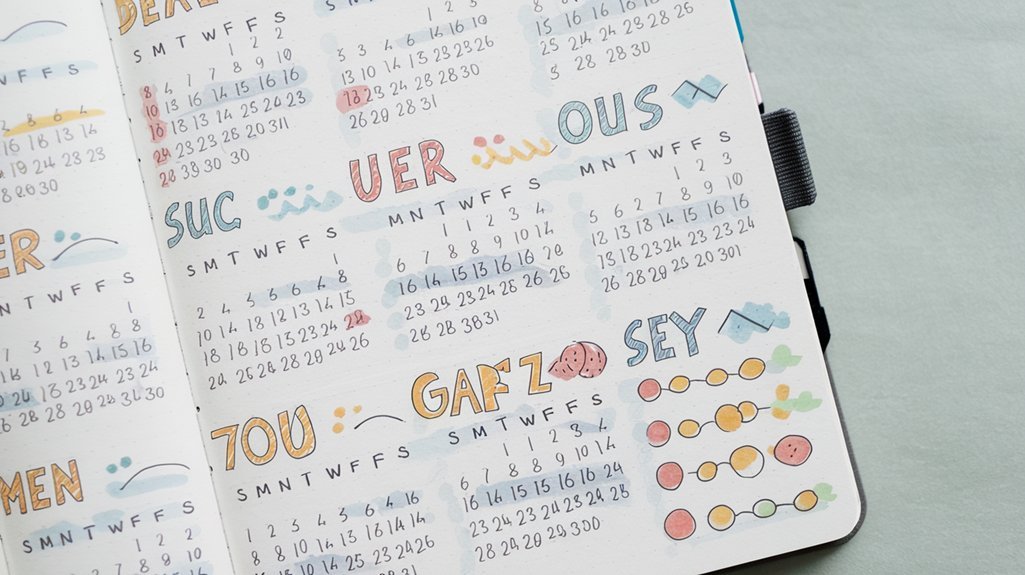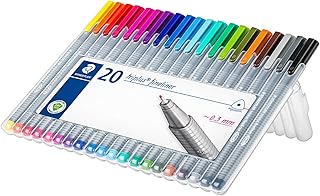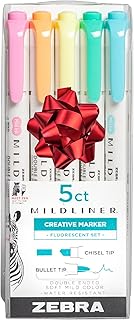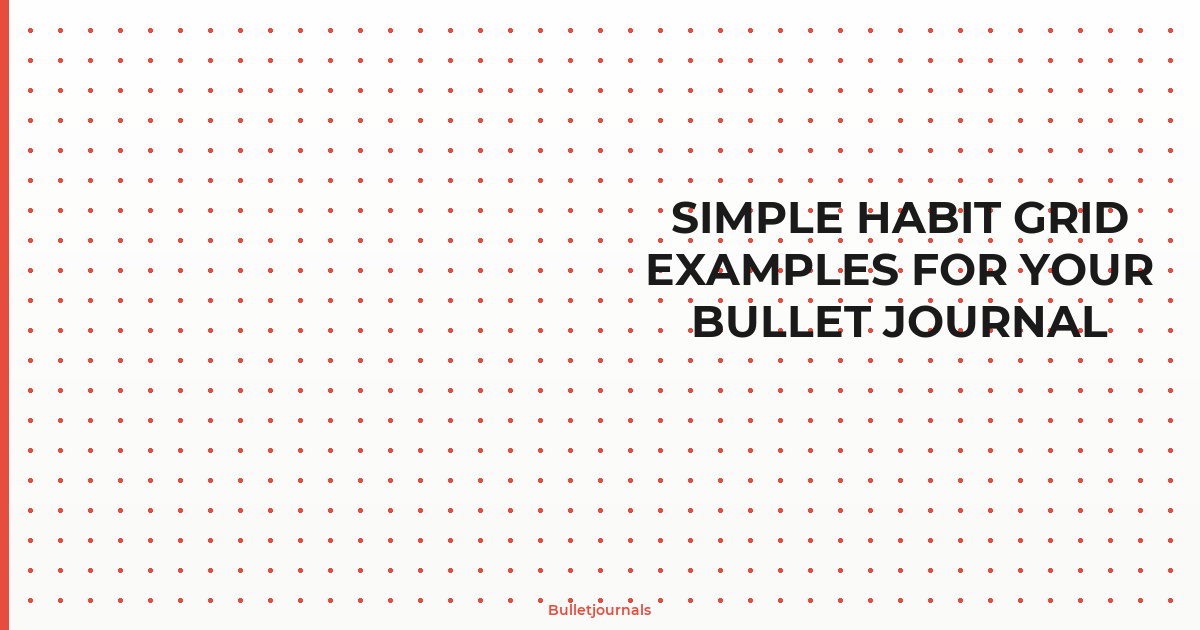Effective goal tracking in a bullet journal combines visual progress markers with systematic check-in routines. Key elements include color-coded spreads, measurable milestones, and regular review systems that transform abstract aspirations into concrete achievements. Successful trackers utilize progress bars, percentage wheels, and mini calendars to monitor advancement at a glance. Weekly and monthly evaluations maintain accountability while documenting insights and celebrating wins. This structured approach unbolts the full potential of goal achievement systems.
Why Traditional Goal Setting Often Fails

Three common pitfalls plague traditional goal-setting methods. First, people often set overly ambitious targets without creating a sustainable path for behavior change. They focus on the destination while neglecting the journey, leading to frustration and abandonment of their objectives. Second, traditional approaches frequently lack a structured tracking system, making it difficult to measure progress and maintain accountability.
The third pitfall involves failing to integrate goals into daily habit formation. When objectives remain separate from regular routines, they become abstract concepts rather than actionable steps. Research shows that successful behavior change requires embedding new practices into existing daily patterns.
These limitations explain why many individuals struggle with conventional goal-setting techniques. The bullet journal method addresses these challenges by combining systematic tracking, gradual progression, and practical implementation. It transforms abstract goals into concrete actions, creating a framework that supports sustained progress through visible metrics and adaptive strategies.
Essential Elements of an Effective Goal Tracker
An effective goal tracker in a bullet journal requires three fundamental components to maximize success. Visual progress markers provide immediate feedback through simple symbols or charts, while regular check-in systems establish accountability through daily, weekly, or monthly reviews. Measurable goal categories transform abstract aspirations into concrete milestones, allowing users to track tangible progress across different areas of their lives.
Visual Progress Markers
Visual progress markers transform abstract goals into tangible achievements through clear graphical representations in a bullet journal. These indicators utilize eye-catching visuals to create an engaging dashboard that helps track momentum and maintain motivation throughout the year.
Common visual markers include progress bars, habit trackers, and milestone checkpoints that showcase advancement toward specific objectives. Color-coding systems enhance the visual hierarchy, making it easier to distinguish between different goals and their respective completion stages. Circular trackers, percentage wheels, and mini calendars offer compact yet effective ways to monitor progress at a glance.
These graphical elements serve dual purposes: they provide immediate feedback on goal progression while creating an aesthetically pleasing spread that encourages regular interaction with the tracking system.
Regular Check-In Systems
Maintaining momentum throughout the year requires structured check-in systems that monitor goal progression at regular intervals. Effective goal tracking incorporates both weekly and monthly review sessions to evaluate progress, identify obstacles, and adjust strategies as needed.
Regular feedback loops serve as critical engagement strategies, helping bullet journal users stay connected with their objectives. Monthly reviews should examine completed tasks, analyze setbacks, and measure progress against established benchmarks. Weekly check-ins focus on immediate action items and short-term adjustments.
Users benefit from implementing a systematic approach: scheduling specific review dates, using consistent evaluation metrics, and documenting insights gained during each session. This structured system guarantees continuous engagement with yearly goals while providing opportunities to celebrate small wins and address challenges before they become significant obstacles.
Measurable Goal Categories
Successful goal tracking in bullet journals relies on establishing clearly defined, measurable categories that align with specific life areas. When organizing yearly goals, individuals should focus on identifying actionable goal metrics that provide concrete evidence of progress.
Common measurable output indicators include:
- Quantifiable targets (numbers, percentages, frequencies)
- Time-based achievements (completion dates, duration metrics)
- Binary accomplishments (done/not done, achieved/pending)
These categories enable systematic tracking of personal and professional development while maintaining clarity in goal assessment. Whether monitoring fitness milestones, financial objectives, or learning targets, each category should incorporate specific measurement criteria. This structured approach transforms abstract aspirations into trackable outcomes, allowing for precise evaluation of progress throughout the year and facilitating necessary adjustments to maintain momentum toward desired results.
Designing Your Yearly Goals Spread
The layout and design of a yearly goals spread sets the foundation for effective goal tracking in a bullet journal. Goal format customization allows journalers to create a system that aligns with their planning style and objectives. The spread should incorporate clear sections for different goal categories while maintaining visual hierarchy through purposeful spacing and typography.
Personalized tracker designs can range from minimal grid layouts to elaborate artistic spreads. Essential elements include dedicated spaces for goal descriptions, progress indicators, and completion dates. Many bullet journalists opt for a two-page layout, positioning annual goals on the left and corresponding tracking mechanisms on the right. Color coding helps distinguish between different goal categories, while symbols or icons can represent milestones and achievements.
The spread should remain functional throughout the year, with adequate space for modifications and notes as goals evolve. Strategic placement of review sections enables regular assessment of progress and necessary adjustments.
Monthly Progress Review Systems

Regular progress tracking empowers bullet journal users to maintain momentum toward yearly goals through three effective monitoring systems. Monthly Habit Score Cards provide a quantitative assessment of daily routines, while Color-Coded Progress Trackers offer visual clarity on goal advancement through simple color assignments. Quick Win Checkpoint Systems supplement these tools by breaking larger objectives into smaller, achievable milestones that can be reviewed and celebrated monthly.
Monthly Habit Score Cards
Monitoring yearly goals becomes more manageable through Monthly Habit Score Cards, which provide a systematic approach to tracking progress and behaviors. These cards integrate seamlessly with daily task management and weekly review habits, creating an all-encompassing system for goal achievement.
Monthly Habit Score Cards typically include:
- A grid layout with days of the month for marking completed habits
- A scoring system to quantify success rates and identify patterns
- A reflection section for noting challenges and improvements
The score cards serve as visual representations of progress, enabling users to identify trends and make necessary adjustments. By maintaining consistent records, individuals can better understand their behavioral patterns and optimize their approach to achieving long-term objectives. This systematic tracking method transforms abstract yearly goals into concrete, measurable actions that can be regularly evaluated and refined.
Color-Coded Progress Trackers
Implementing color-coded progress trackers creates a visually intuitive system for reviewing monthly advancement toward yearly goals. Through custom color palettes, users can designate specific hues for different goal categories, making it easier to identify patterns and areas needing attention at a glance.
The effectiveness of these trackers lies in their personalized design elements, which can include gradient scales, symbols, or geometric shapes. Each color represents a distinct goal type: green for financial objectives, blue for personal development, red for health targets, and yellow for creative pursuits. Users can mark progress levels using color intensity variations, where darker shades indicate higher achievement rates.
This systematic approach enables quick assessment of goal progression while maintaining an organized, aesthetically pleasing layout that enhances motivation and accountability throughout the year.
Quick Win Checkpoint Systems
Building upon the color-coding system, Quick Win Checkpoint Systems offer bullet journal users a structured monthly review framework that breaks down yearly goals into smaller, achievable milestones. These personalized reward structures transform goal tracking into manageable, gamified achievement systems that maintain motivation throughout the year.
The checkpoint system incorporates three key elements for maximum effectiveness:
- Monthly milestone markers that align with specific target dates
- Achievement badges or stickers to visually represent completed objectives
- Mini-reward triggers that activate when reaching predetermined checkpoints
Users can review their progress systematically while celebrating small victories along the way. This approach prevents goal abandonment by creating regular touchpoints and maintaining engagement through visible progress indicators. The system's flexibility allows for adjustments based on individual pace and changing circumstances throughout the year.
Creative Ways to Visualize Goal Progress

Vibrant goal trackers transform mundane progress monitoring into an engaging visual experience. Bullet journal enthusiasts can leverage visually appealing timelines and eye-catching progress visualization techniques to maintain motivation throughout the year.
| Tracker Type | Visual Element | Implementation |
|---|---|---|
| Growth Chart | Plant/Tree | Add leaves for milestones |
| Habit Grid | Color Blocks | Fill squares progressively |
| Journey Map | Mountain Path | Mark steps to summit |
These creative tracking methods provide instant visual feedback while maintaining the functional aspects of goal monitoring. Users can implement circular trackers that fill like a pie chart, create geometric patterns that expand with each achievement, or design themed trackers aligned with specific goals. For fitness goals, practitioners might draw sneakers to color in for each workout, while readers could sketch books on shelves to represent completed titles. The key lies in selecting visualization methods that resonate personally while providing clear progress indicators.
Habit Tracking Methods That Support Your Goals
Successful habit tracking requires strategic methods that align directly with established goals. By integrating proven goal setting strategies with effective habit formation techniques, bullet journal users can develop systems that foster consistent progress monitoring and verification.
Strategic habit tracking paired with intentional goal-setting creates a powerful framework for measuring and maintaining meaningful progress.
Core habit tracking methods include:
- Daily habit trackers with simple checkboxes or symbols to mark completion, allowing for quick visual assessment of consistency
- Monthly tracker spreads that combine multiple habits on one page, enabling pattern recognition and correlation analysis
- Progress bars or milestone markers that connect specific habits to larger goals, maintaining focus on desired outcomes
These tracking methods become more powerful when synchronized with regular review periods. Weekly or monthly evaluations help identify which habits directly support goal achievement and which need adjustment. This systematic approach to habit monitoring verifies that daily actions remain purposefully connected to long-term objectives, maximizing the effectiveness of goal pursuit strategies.
Maintaining Motivation Through Strategic Check-ins

Regular check-ins serve as essential motivation anchors in the bullet journal goal-tracking process. By establishing milestone checkpoints throughout the year, individuals can systematically evaluate their progress and adjust strategies as needed. These structured reviews prevent goals from falling by the wayside and maintain forward momentum.
Strategic check-ins work best when scheduled at consistent intervals, such as monthly or quarterly reviews. During these sessions, bullet journalists should assess both quantitative progress and qualitative experiences. Documenting challenges, breakthroughs, and lessons learned provides valuable context for future planning.
Incorporating accountability partners into the check-in process adds an external layer of support and commitment. These partners can offer objective feedback, celebrate achievements, and help troubleshoot obstacles. Whether meeting virtually or in person, scheduled accountability sessions transform solitary goal pursuit into a collaborative journey. This social element strengthens resolve and increases the likelihood of sustained progress toward yearly objectives.
Adapting Your Goals Throughout the Year
While initial goal-setting provides direction, the ability to adapt objectives throughout the year remains essential for long-term success in bullet journaling. Regular assessment enables flexible goal adjustments that reflect changing circumstances, priorities, and personal growth. By implementing responsive goal modifications, individuals maintain realistic expectations while progressing toward their aspirations.
Key strategies for adapting goals include:
- Conducting monthly reviews to evaluate progress and identify necessary adjustments based on current circumstances
- Breaking down larger goals into smaller, manageable milestones that can be modified as needed
- Creating alternative paths or backup plans when original approaches prove ineffective
This dynamic approach to goal management prevents stagnation and maintains momentum throughout the year. Rather than viewing changes as setbacks, bullet journal users should embrace adaptability as a strength. Adjusting goals demonstrates self-awareness and commitment to meaningful progress, ensuring that yearly objectives remain both challenging and attainable.
Celebrating Milestones and Achievements

Recognizing accomplishments throughout the bullet journal journey strengthens motivation and reinforces positive goal-tracking behaviors. By implementing a systematic approach to celebrating small wins, individuals can maintain momentum and stay committed to their yearly objectives.
Effective milestone celebration in bullet journaling involves creating dedicated spaces to document achievements. Users can designate special pages for victory logs, progress charts, or achievement galleries. These visual representations help in recognizing incremental progress and provide tangible evidence of growth throughout the year.
Successful bullet journalists often incorporate various celebration methods, such as using colorful stickers, creating milestone badges, or designing special spreads for major accomplishments. Some practitioners also benefit from establishing reward systems tied to specific achievements. This structured approach to acknowledgment helps maintain focus while providing regular doses of encouragement, making the goal-tracking process more engaging and sustainable.
Conclusion
Successful goal tracking in a bullet journal requires dedication, adaptability, and strategic planning. Through purposeful design, consistent monitoring, and meaningful celebrations, journalers transform abstract aspirations into tangible achievements. Like a compass guiding a journey, the bullet journal steers individuals toward their desired destinations – one page, one goal, one milestone at a time. When implemented thoughtfully, these tracking systems become powerful catalysts for personal growth and accomplishment.
Tracker Supplies
Affiliate links – we earn from qualifying purchases.


















